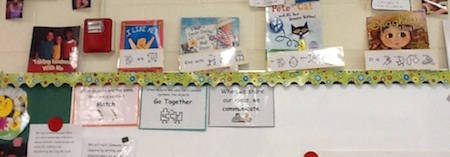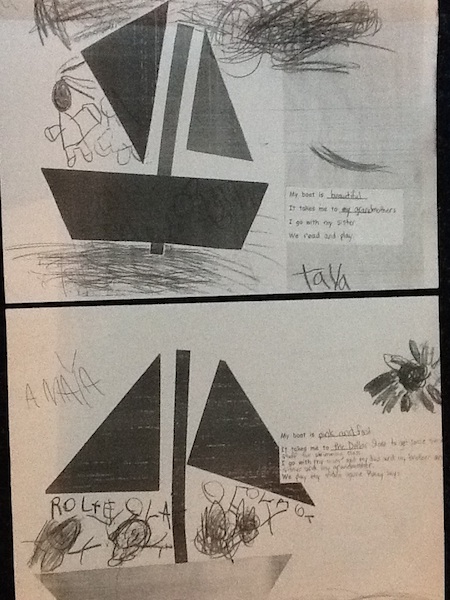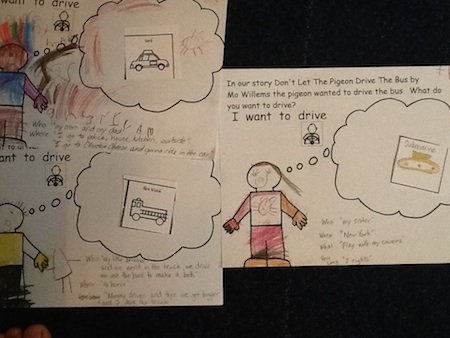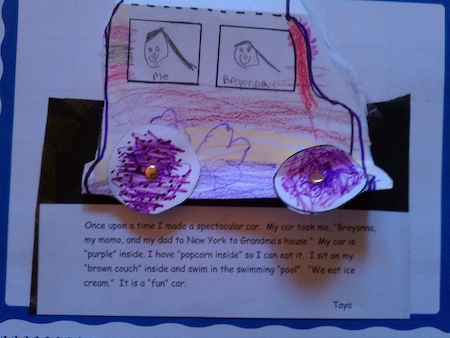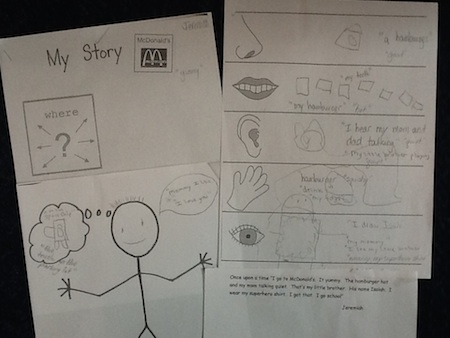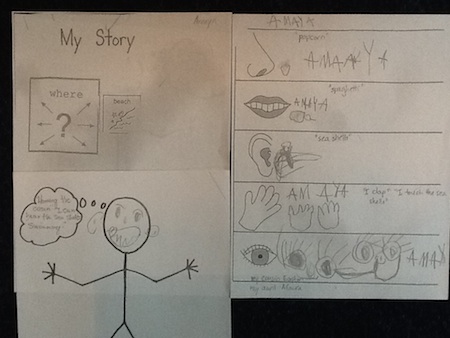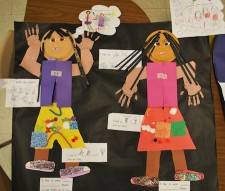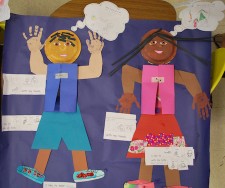Everybody Has a Story: Telling Our Stories in Pre-Kindergarten
by Christie Furnari
In Fall, 2012, I began another year working with our ART Literacy Community. I have been teaching pre-kindergarten for 8 years. This past year my linguistically diverse classes included up to 21 students in the morning and 19 students in the afternoon. The 40 students included 25 girls and 15 boys. Sixteen of these spoke primarily Spanish in their home and seven other children spoke one of five other languages in their homes.
As in the previous year, I read lots of global literature to the children. Nine of the books were particularly strong and so I decided to revisit these books with students throughout the year. I created a book wall above our chalkboard by the carpeted area so that the books were available to use as a reminder, to compare, and to reread as a favorite read aloud. By the end of the year we had a line of books on our wall. I taped a sentence strip to the book that included board maker pictures and summed up the message in one sentence (see Figure 1).
The children shared responses to these books and other books throughout the year through artwork, discussion, dictation of ideas, drawing/writing in journal books, and finally creating their own stories. In this vignette, I share our experiences with some of the books and how I used them to help students grow in their appreciation of themselves and others, to explore imagination and story, and to tell their own stories.
Learning About Ourselves and Others
The first half of the year I focused on broadening the concept of same/different in objects, characters, themselves, thinking, etc. We read books such as I Like Me! (Carlson, 2009) and children drew self-portraits and shared information about their likes and their lives. They used words and pictures to communicate what they liked to do at home and school and with family and what they liked to eat. This was the beginning of our investigation into ourselves and noticing similarities and differences with classmates. We also read Pete the Cat and His Four Groovy Buttons (Litwin, 2012) and discussed ways we react in situations, how to take a deep breath, and what choices we can make when we lose objects or need help so we can keep on singing.
As we continued to focus on ourselves and our similarities and differences, we moved into the theme of family. We used many nonfiction books to build on our understanding of ourselves and others in the context of our families. Families (Easterling, 2007), Homes (Mayer, 2007), Loving (Morris, 1990), Shades of People (Rotner & Kelly, 2009), and You and Me Together (Kerley, 2005) were read-aloud books. We discussed these books and students responded in different ways, including creating an early year drawing response book about ourselves and our families.
As we expanded our discussions to look at peers and friends, we read Pigeon Finds a Hot Dog (Willems, 2004) and talked about sharing. We also talked about the speech/thinking bubbles Mo Willems used so the Pigeon could share his thoughts. When we read Dear Daisy, Get Well Soon (Smith, 2000), we discussed how we can take care of friends. Taking Kindness With Me (Chappell, 2007) was a nonfiction book that provided examples of kindness that helped children understand what it means to be kind. We also read How Does Your Brain Work? (Curry, 2003) to learn information on our amazing brains. We built on this book often as the year continued.
Throughout our exploration of these themes we used a Velcro chart created for sign-in (attendance) for the day. Each day I wrote a question at the top of the chart and under the question were picture choices. When the students understood the question of the day, they made a selection by placing their name under the picture representing their choice, thus organizing our responses into a picture graph. I selected questions that allowed the students to share information about ourselves (i.e., our favorite food, animal, letter, color, shape, number of family members, homes, etc.). As we looked at the picture graph each day, we talked about whose responses were similar and whose were different. We celebrated our different choices and differences because our differences make us unique. We also revisited books from our book wall such as Whoever You Are (Fox, 2006), Spaghetti on a Hot Dog Bun (Dismondy, 2008), and The Orange Splot (Pinkwater, 1977) that celebrated differences. Throughout these discussions we recognized and used speech bubbles or thinking bubbles in our classroom as a way to share and celebrate special thoughts and words.
Exploring Imagination and Story
The second half of the year, the read-aloud books focused children on using their imaginations to tell their special and unique stories. We talked about using facts and fiction in our stories. Sometimes I gave sentence starters to children to help them get going. For example, as part of our transportation unit, we shared Changes, Changes (Hutchins, 1987). At the art center students followed picture directions to make a boat picture out of paper shapes and add drawings and writing to complete their pictures. They dictated their responses to sentence starters using their imaginations to tell a story about their pictures. I wrote exactly what the children said. Sometimes they responded in sentences and sometimes with a few words. Taya’s and Amaya’s drawings and stories are in Figure 2.
Taya wrote, “My boat is beautiful. It takes me to my grandmother’s. I go with my sister. We read and play.” Amaya wrote, “My boat is pink and fast. It takes me to the Dollar store to get some swim stuff for swimming class. I go with my mom and my dad and my brother and my sister and my grandmother. We play my video game Pokey Says.”
After reading Don’t Let the Pigeon Drive the Bus (Willems, 2003) students chose a form of transportation they thought would be fun to drive. They used their imaginations to respond to question words (who, where, what, how long) as prompts to create their stories (see Figure 3).
Finally, we read Amelia’s Fantastic Flight (Bursik,1992) and talked about how that book was Amelia Earhart’s story and that every person has a story! We then read If I Built a Car (Van Dusen, 2005) and the children decorated their own cars. The children dictated their stories by responding to question words that I attached to their cars. Taya’s car is in Figure 4.
Her story was, “Once upon a time I made a spectacular car. My car took me, Breyanna, my momo, and my dad to New York to Grandma’s house. My car is purple inside. I have popcorn inside so I can eat it. I sit on my brown couch inside and swim in the swimming pool. We eat ice cream. It is a fun car.”
These experiences helped children recognize that everyone has a story and apply this thought to artists we studied in our Baltimore Museum of Art program on Language through the Arts. We realized that we can all be artists and authors and tell our own stories. Later in the year, at the end of our unit on the senses, the children chose a picture of a place (their home, McDonalds, Walmart, Target, grandparents’ home, etc.) as their setting and drew other parts of their stories. They told their stories by sharing what they would see, hear, taste, touch, and smell in the setting they chose. Jeremiah’s story (see Figure 4a) was, “Once upon a time I go to McDonalds. It yummy. The hamburger hot and my mom talking quiet. That’s my little brother. His name Isaiah. I wear my superhero shirt. I got that. I go to school.” Amaya’s work is in Figure 5. Her thinking bubble says, “Hearing the ocean. I can hear the sea shells swimming.” Through all of these experiences the students realized they were writers and artists.
The last six weeks of school I pulled together what we had talked about all year with the books on our book wall to encourage children to share what they know about themselves to tell their stories. I worked with our pre-kindergarten art teacher Katie to help the children each construct our pre-kindergarten version of their own “cultural x-ray” (Short, 2009). Each week the children worked on a different part of their bodies and told a story related to that part:
•We started with our feet/shoes, reading Shoes, Shoes, Shoes (Morris, 1998) and New Shoes, Red Shoes (Rollings, 2001). The children painted and glittered their favorite shoes and completed sentences to tell about their favorite shoes.
•We read Come Out and Play (Ajmera & Ivanko, 2001) and I Like to Play (Konrad, 2010) and talked about what we can do with our bodies. In art the children created shorts/skirts and legs, connecting their legs to their shoes.
•After reading These Hands (Price, 2007), the children chose pictures of things they like to do with their hands. We revisited Shades of People (Rotner & Kelly, 2009) to match skin tones to make handprints.
•We talked about how everyone likes different things and that’s ok. We revisited a number of books, including Spaghetti on a Hot Dog Bun (Dismondy, 2008) and The Big Orange Splot (Pinkwater, 1977). Children made their hearts and added pictures, letters, and words of things they love. To make these things they like pop out of their hearts, we accordion-folded small strips of paper that attached the hearts to the back of the shirt. The hearts were now inside the shirts which folded over them and were fastened to keep them closed.
•The last week, we talked about heads and the children made the head for their figure in art. We used paper plates, paint, tissue paper, white paper with black for eyes, and yarn for hair. We read Someday (Spinelli, 2007) and discussed all the amazing things each of them could choose to do when they grow up. Each child drew pictures, used their writing, and dictated words to share what they wanted to do when they grew up.
At the end of the six weeks, each child had a 2 foot figure of themselves with lots of stories in writing and art. Figure 6 and Figure 7 show some of the figures.
I video-interviewed the children about their work and their thoughts about messages we discussed this year. It was interesting to learn each student’s favorite author’s message from the book wall book in these clips. Here are some student video clips.
I had two amazing classes of students who left pre-kindergarten with a better understanding of themselves, respect for others, the importance we each have in the world, and the knowledge that they have lots of wonderful stories to tell that matter. They will enter kindergarten knowing their brains are the same as others but also different, allowing them to think, imagine, talk, and create in unique ways that make them special.
References
Ajmera, M., & Ivanko, J. (2001). Come out and play. Watertown, MA: Charlesbridge.
Bursik, R. (1992). Amelia’s fantastic flight. New York: Henry Holt.
Carlson, N. (2009). I like me! New York: Puffin.
Chappell, J. (2007). Taking kindness with me. Vero Beach, FL: Rourke Publishing.
Curry, D. (2003). How does your brain work? Danbury, CT: Children’s Press.
Dismondy, M. (2008). Spaghetti on a hot dog bun. (Illus. by K. Shaw-Peterson). Northville, MI: Ferne Press.
Easterling, L. (2007). Families. Portsmouth, NH: Heinemann.
Fox, M. (2006). Whoever you are. (Illus. by L.Staub). New York: Houghton Mifflin Harcourt.
Hutchins, P. (1987). Changes, changes. New York: Aladdin.
Kerley, B. (2005). You and me together: Moms, dads, and kids around the world. Washington, D.C.: National Geographic.
Konrad, M. (2010). I like to play. Toronto: Tundra Books.
Litwin, E. (2012). Pete the cat and his four groovy buttons. (Illus. by J. Dean). New York: HarperCollins.
Mayer, C. (2007). Homes. Portsmouth, NH: Heinemann.
Morris, A. (1994). Loving. (Illus. by K. Heyman). New York: HarperCollins.
Morris, A. (1998). Shoes, shoes, shoes. New York: HarperCollins.
Pinkwater, D. (1977). The big orange splot. New York: Scholastic.
Price, H. (2007). These hands. (Illus. by B. Collier). New York: Jump At the Sun.
Rollings, S. (2001). New shoes, red shoes. New York: Orchard Books.
Rotner, S., & Kelly, S. (2009). Shades of people. New York: Holiday House.
Smith, M. (2000). Dear Daisy, get well soon. New York: Crown Books.
Spinelli, E. (2007). Someday. (Illus. by R. Winstead). New York: Dial.
Van Dusen, C. (2007). If I built a car. New York: Puffin.
Willems, M. (2003). Don’t let the pigeon drive the bus! New York: Hyperion Press.
Willems, M. (2004). Pigeon finds a hot dog. New York: Hyperion Press.
Christie Furnari teaches pre-kindergarten at Pot Spring Elementary School in Timonium, Maryland.
WOW Stories, Volume IV, Issue 7a by Worlds of Words is licensed under a Creative Commons Attribution-NonCommercial-ShareAlike 4.0 International License.
Based on a work at <a href="wowlit.org/on-line-publications/stories/storeisiv7a".

